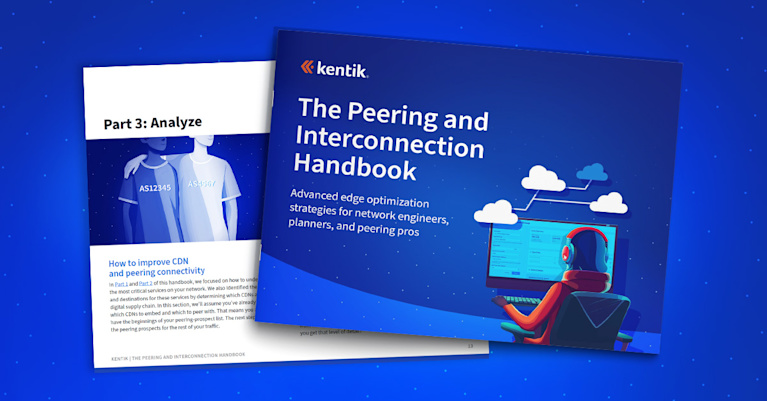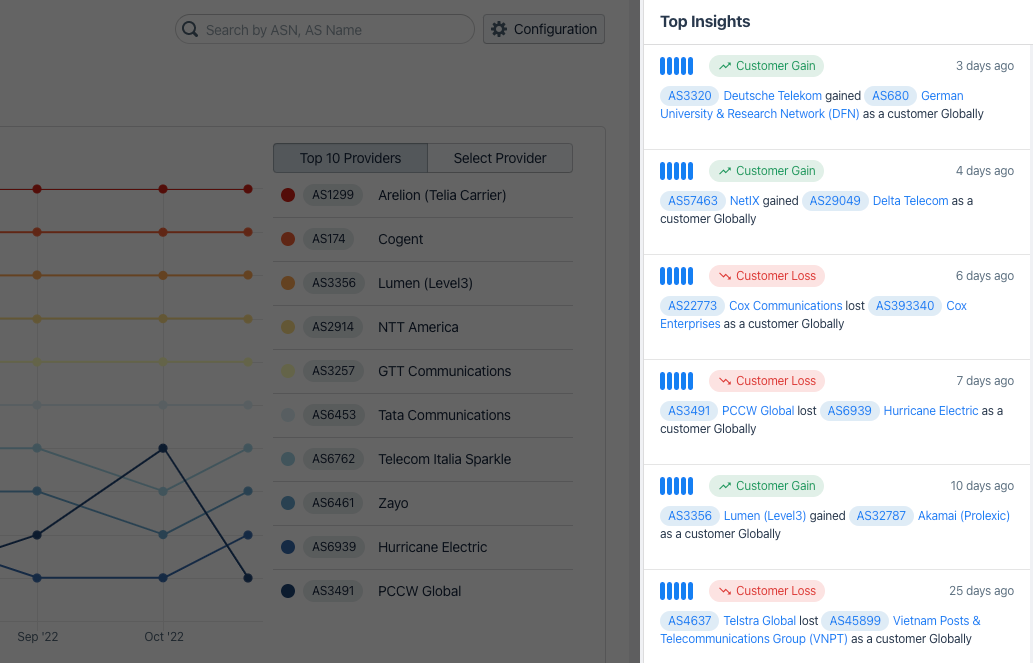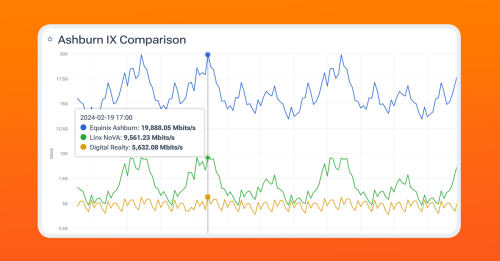IP Transit vs Peering: What’s the Difference?
IP Transit and Peering are two types of interconnections that play a crucial role in the global internet connectivity landscape. Both options have their own unique characteristics, advantages, and use cases. This article provides an overview of IP Transit and Peering, highlighting the key differences and benefits of each method.
What is Internet Peering?
Internet peering is a direct connection between two IP networks, allowing them to exchange traffic without using the public internet. Peering is useful for reducing transit costs, improving network performance, and enhancing security. For a detailed understanding of internet peering, visit the Kentipedia entry for What is Internet Peering?.
Public vs private peering
Internet peering can be divided into two types: public peering and private peering.
Public peering
Public peering occurs through an internet exchange point (IXP), where multiple networks connect to exchange traffic. Public peering leverages BGP (Border Gateway Protocol) and enables networks to efficiently route traffic by connecting to several networks through a single IXP.
Private peering
Private peering involves a dedicated IP connection between two networks to exchange traffic directly. This type of peering is ideal when a large volume of traffic needs to be exchanged, offering greater control and performance compared to public peering.
What is IP Transit?
IP Transit is a commercial service that allows internet service providers (ISPs) to connect their customers’ networks to the global internet. It involves routing traffic through multiple networks, which may include peering relationships and transit agreements. IP Transit is crucial for maintaining global internet connectivity.
How do IP Transit services work?
IP Transit works by routing customer traffic through ISPs and transit providers, eventually reaching the global internet. BGP is used to determine the optimal path for traffic. Costs associated with IP Transit vary depending on factors such as bandwidth usage and provider choice.
Advanced edge optimization strategies for network engineers, planners, and peering pros

Choosing the right IP Transit provider
IP Transit providers can be classified into three tiers. Understanding the differences between these tiers is essential for selecting the right provider for your needs.
Tier 1 ISPs
Tier 1 ISPs are the largest and most established providers in the industry. They can connect to other Tier 1 providers for free, offering the most extensive global network reach. Examples of Tier 1 providers include AT&T, Verizon, CenturyLink, Arelion and GTT.
Tier 2 ISPs
Tier 2 ISPs operate on a smaller scale compared to Tier 1 providers. They have their own networks but also rely on transit agreements with Tier 1 ISPs to achieve global reach. Examples of Tier 2 providers include Comcast, British Telecom, and KDDI.
Tier 3 ISPs
Tier 3 ISPs are smaller, local providers that focus on delivering cost-effective solutions to their customers. They rely heavily on transit agreements with higher-tier providers to connect to the global internet. Tradeoffs include lower efficiency and more limited network reach.
When choosing an interconnectivity provider, there is no “one size fits all” solution. Each tier has its advantages and disadvantages. Tier 1 providers offer global reach, but at a higher cost and with less flexibility. Tier 2 providers balance cost and performance, while Tier 3 providers offer greater customization and lower costs, but may have limited reach. Considering your networking needs and goals is essential when making a decision.
IP Transit Ranking
Selecting the right transit provider to fit your needs is often considered to be just a matter of getting the lowest price, but if you are conscious about your peering setup or if you deliver content to specific markets, going with the current lowest bidder might not be the right move. So what to look for? This is where tools like Kentik Market Intelligence (KMI) can help by providing IP transit rankings of all the ASNs in the world.
What is Kentik Market Intelligence (KMI)?
KMI enables users to easily navigate the insights and dynamics hidden in the global routing table by identifying the ASes operating in any given geography, determining their providers, customers and peers, and alerting you when there are changes to those relationships.
Additionally, KMI produces IP transit rankings based on the volume of IP space transited by ASes in different geographies. Using tables and charts, KMI offers a global view of the internet.

KMI uses public BGP routing data to rank ASes based on their advertised IP space. Rankings are updated daily and come in various forms: total customer base, customer type (retail, wholesale, backbone), as well as peering.
How to Use KMI to Select the Right Transit Provider
KMI can be useful in choosing transit providers, regardless of your approach to connectivity. Let’s consider a few examples.
Focus on Optimal Connectivity
For networks where peering isn’t viable or sufficient, securing a short and efficient path to your target ASN (Autonomous System Number) is paramount. KMI helps understand which providers a target ASN uses, as well as which ASNs they peer with. This offers a clear map towards choosing your ideal providers. The regional IP transit rankings for retail networks will show which ASNs have the most end user address space, so choosing a top ASN will secure a short AS path to the end users of your content.
Focus on Regional Connectivity
If your focus is on establishing robust connectivity within a specific region—be it a state, country, or a selected region—KMI’s rankings offer invaluable insights. For example, to ensure extensive reach within Argentina, referring to KMI’s country ranking for Argentina would guide you to the most capable provider in that area.
Focus on Global Connectivity
For networks needing worldwide reach, KMI’s global rankings shed light on which providers offer the most comprehensive connectivity when analysing the global routing table. This global view ensures that your services are accessible to all internet users.
The Bottom Line
Choosing the right IP transit provider is a critical decision that can significantly affect your network’s performance and reliability. IP transit ranking tools like Kentik Market Intelligence (KMI) offer a data-driven approach to these decisions. Whether you’re seeking optimal connectivity, regional focus, or global reach, leveraging the insights provided by IP transit rankings ensures that you can select a provider that best meets your network’s unique requirements, ultimately securing a resilient and efficient pathway to the global internet.
What are the Major Differences Between Peering and IP Transit?
The key differences between peering and IP transit lie in their connectivity methods, cost structures, and levels of control. Peering offers direct connections between networks, often resulting in better performance and security, while IP transit relies on multiple networks and transit agreements to achieve global reach.
Assessing the Benefits of Peering Over IP Transit
When evaluating the advantages of peering compared to IP transit, it’s crucial to weigh the various factors that may influence your decision. These include security, performance, reliability, costs, and control. By carefully considering each aspect, you’ll be better equipped to determine the most suitable option for your specific needs.
Security
Peering offers enhanced security due to its direct connection between two networks. This limits the exposure to potential threats, reducing the risk of data sniffing and internet-based exploits. In contrast, IP transit relies on routing traffic through multiple networks, which may increase vulnerability to attacks and surveillance.
Performance
With peering, performance is generally superior, as latency and capacity are controlled solely by the two parties involved. This direct connection provides a better user experience for ISP customers. IP transit, on the other hand, involves routing traffic through multiple networks, which can lead to increased latency and potential performance degradation.
Reliability
Peer networks tend to be more reliable, as they are less likely to be disrupted by issues such as DDoS attacks on an ISP’s infrastructure. IP transit, however, relies on multiple networks, which can introduce additional points of potential failure, affecting overall network stability and reliability.
Cost
While peering can require significant initial investment, it can help reduce ongoing operating expenses by providing a direct path to exchange traffic, bypassing transit providers. IP transit often involves higher costs, as businesses must pay fees to send data over the public internet and maintain agreements with multiple providers.
Control
Peering provides increased control over the quality-of-service, as it connects directly to the networks that are critical to you or your customers. This is particularly valuable in cases where continuous, reliable network traffic is essential, such as video streaming (for an example of how Kentik is used for peering analytics in such use cases, see our video “How Zoom Uses Kentik for Network Visibility & Performance”. IP transit, in contrast, offers less control over performance, as it relies on multiple networks and agreements with various providers.
Additional Considerations
When comparing IP Transit and Peering, it’s important to consider several additional factors that can influence the best choice for your organization. These include scalability, network neutrality, regional differences, and the possibility of adopting a hybrid approach.
Scalability
Peering and IP transit scale differently to accommodate growing traffic demands. Peering might require additional investments in hardware and private connections as traffic volume increases, whereas IP transit can be scaled more easily by adjusting agreements with providers. Evaluate the scalability of each option based on your organization’s growth projections and anticipated traffic patterns.
Network Neutrality
Network neutrality concerns can arise in some peering agreements, where ISPs may prioritize certain types of traffic or content providers. In contrast, IP transit generally adheres to the principle of network neutrality, treating all traffic equally. Assess your organization’s stance on network neutrality and its potential impact on your choice of interconnectivity method.
Regional Differences
The choice between IP Transit and Peering may vary depending on the region. Peering might be more advantageous in areas with high traffic density and well-developed IXPs, while IP transit could be a better option in areas with less developed infrastructure or lower traffic density. Consider regional factors when deciding which method best suits your organization’s needs.
Hybrid Solutions
Organizations can strategically combine IP Transit and Peering in a complementary manner to optimize network performance, costs, and reliability. By adopting a hybrid approach, you can take advantage of the benefits provided by each method. For example, you might use peering for high-priority, latency-sensitive traffic while relying on IP transit for broader network access. Evaluate whether a hybrid solution is the best fit for your organization based on your specific needs and goals.
Summary of Differences between IP Transit and Peering
The major differences between peering and IP transit lie in their cost, performance, control, and security. Peering offers direct connections with lower latency, better performance, and increased reliability, while IP transit provides broader network access at a potentially higher cost.
Kentik Solutions for Data-driven Peering and Interconnection
Discover how Kentik’s data-driven peering and interconnection features can help your organization make crucial decisions about peering versus IP transit. Our platform provides valuable insights into your network traffic, allowing you to make informed decisions, improve network performance, and control costs. To learn more, request a demo or sign up for a free trial today.

